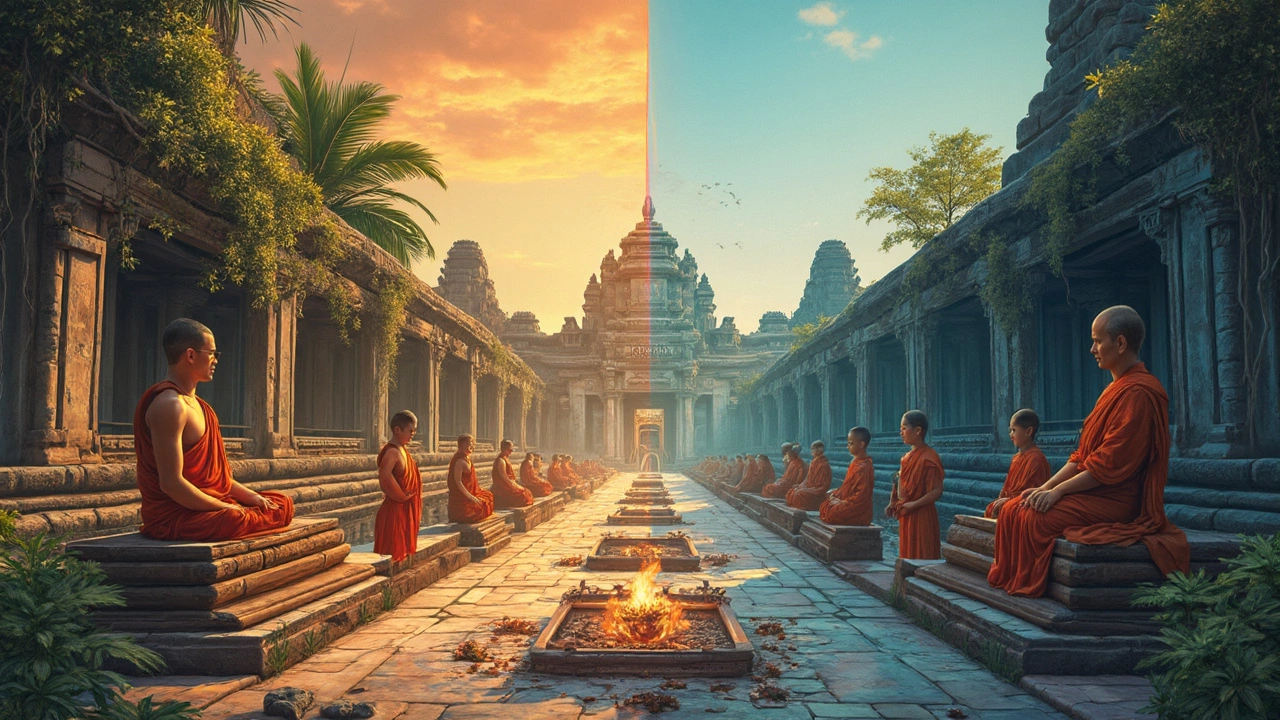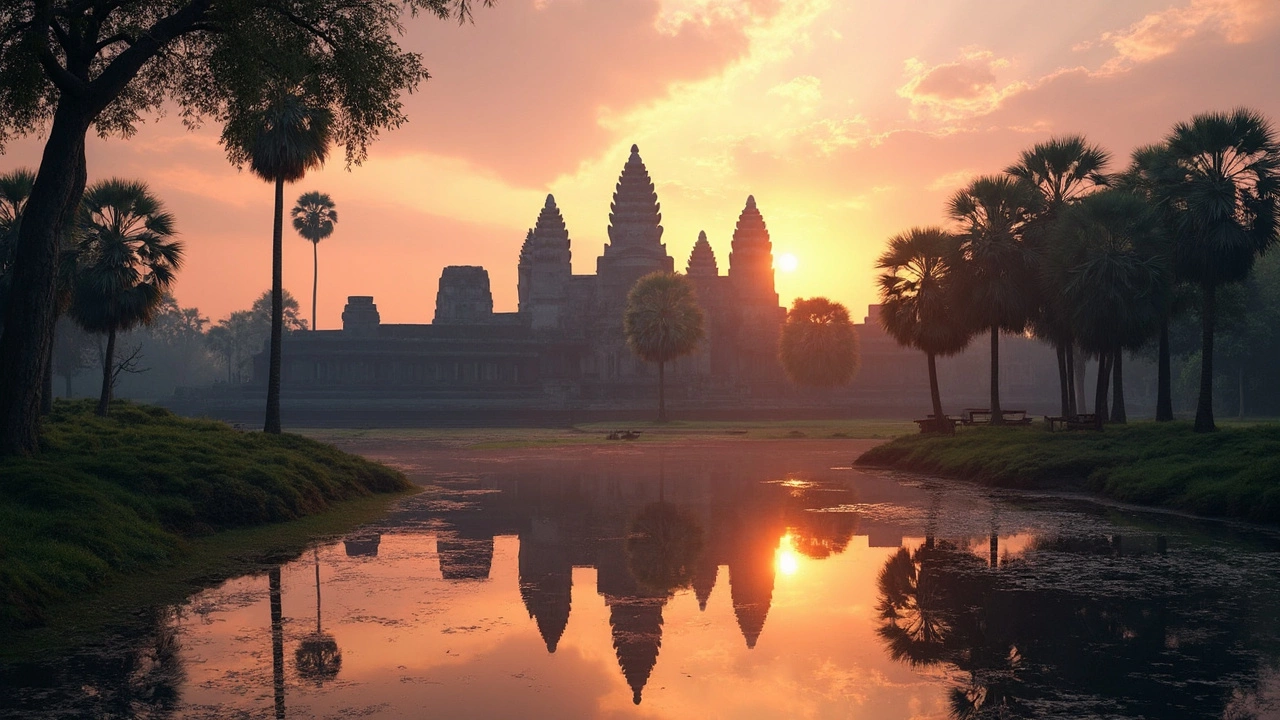Ever find yourself pondering whether Angkor Wat swings team Hindu or Buddhist? You're not alone! This incredible site in Cambodia holds more than just bricks and stones; it's a tapestry of shifting cultural influences. It first rocked the spiritual scene around the early 12th century, rich in Hindu symbolism and dedicated to the god Vishnu.
Fast forward a few centuries, and a fascinating twist—the place started to embrace Buddhism. This wasn't some random change of heart, though. It reflects the broader changes happening in Southeast Asia, where religions mingled like folks catching up at a neighborhood cookout. Suddenly, you get this amazing blend that keeps historians buzzing and tourists intrigued.
- Origins of Angkor Wat
- Hindu Influence and Architecture
- Transformation to Buddhism
- Cultural and Religious Significance
- Modern-Day Importance
- Visiting Tips for Travelers
Origins of Angkor Wat
Angkor Wat is like that one friend in high school who was super popular—everyone's heard of it, but do you really know its story? Well, let's hop into the time machine and head back to the early 12th century. The temple was initially built during the reign of King Suryavarman II, a ruler of the Khmer Empire. He envisioned Angkor Wat as a Hindu temple dedicated to Vishnu, a major god in Hinduism who holds some serious celestial clout.
What's captivating is the sheer scale and ambition of the construction. Imagine a project that involved thousands of skilled workers, artisans, and laborers. They used sandstone, ferried from a quarry miles away, and assembled one of the largest religious monuments in the world. We're talking over 162 hectares. That's almost like 300 football fields!
Back then, the empire was thriving, and the temple wasn't just a place for worship. It was practically the emperor's version of a social media profile—a statement of power, influence, and religious devotion. The architecture and layout were meticulously aligned with cosmic cycles and celestial bodies. If you squint hard enough, you might see this deep symbolism in every carving and corridor.
There's a cool mix of art and history here, with intricate carvings depicting Hindu epics like the Ramayana and Mahabharata. These hang out alongside other symbols of power and divinity. The temple's layout was designed to represent Mount Meru, the center of the universe in Hindu—and later Buddhist—beliefs. Talk about aiming for the stars!
Hindu Influence and Architecture
Angkor Wat is a gem of Khmer architecture that first saw the light of day under the Hindu wing. Built during the reign of King Suryavarman II in the early 12th century, this marvel was initially a grand tribute to Vishnu, one of the principal deities in Hinduism. Imagine a massive temple complex that stretches over 162 hectares — that's larger than some countries! This vastness showcases the determined effort to reflect the cosmos in stone.
The whole design of Angkor Wat is super symbolic and follows the Hindu concept of Mount Meru, which in their beliefs is the center of the universe. This ain't your average flat-lay bricks and mortar; it's all about layers and levels with multiple towers soaring up like peaks on a mountain. The main central tower, with its significant height of approximately 65 meters, signifies Mount Meru's peak.
Take a walk around, and you can't miss the intricate carvings and bas-reliefs that splash the walls with stories. These carvings typically depict scenes from the Hindu epics like the Ramayana and Mahabharata. If you look closely, you'll also spot rows of dancing Apsaras, heavenly nymphs, flitting across the stone walls in their elegant, celestial dance.
Angkor Wat's orientation also breaks the mold. Unlike most Hindu temples, which face east, Angkor Wat was constructed to face the west, which is associated with Vishnu. There's some academic chatter that suggests this could indicate a focus on death and funerary rituals, fitting given it doubled as a king's mausoleum.
All these bits and pieces are what give Angkor Wat its undeniable Hindu flavor. Whether it's the alignment, the sculptures, or the vast moat that surrounds it like an ocean encircling the earth, these architectural choices scream Hindu myth and lore.
Transformation to Buddhism
So, what sparked the shift from Hinduism to Buddhism at Angkor Wat? Well, it wasn’t like flipping a light switch. This transformation unfolded over several centuries, particularly starting in the 14th century. By that time, Theravada Buddhism was making waves across Southeast Asia, reshaping spiritual landscapes.
The driving force behind this shift? Societal and political changes. As Khmer kings started to adopt Buddhist practices, the momentum naturally led to Angkor Wat's conversion. The temple needed to mirror the evolving faith of its leaders and the populace, so Buddhist imagery and monuments began appearing more prominently.
Buddhism wasn’t just a new religious layer; it refreshed Angkor Wat’s vibes and architectural aesthetics. Statues of the Buddha gradually took residence amongst the original Hindu carvings. Some Vishnu statues were even replaced, highlighting the integration of Buddhist ideals.
This transition wasn't just about new religious symbols. It signified how regions adapt and evolve in response to internal and external pressures. Angkor Wat’s transformation underscored the Khmer Empire’s openness to change, preserving ancient traditions while embracing fresh spiritual influences.
Today, visitors can still see this rich tapestry, a blend of cultures right there in the stonework. Wandering through its halls, it's evident that Angkor Wat stands as a testament to the region's dynamic spiritual evolution, fascinating both history geeks and casual travelers alike.

Cultural and Religious Significance
Angkor Wat isn't just a jaw-dropping architectural wonder; it's a living piece of religious history. Originally intended as a Hindu temple, it showcases a wealth of sacred Hindu iconography scattered throughout its carvings and reliefs. The temple's layout itself is a representation of Mount Meru, a mythical mountain in Hindu cosmology, believed to be the center of the universe.
But this temple didn't stop there. Over time, Angkor Wat underwent a transformation to embrace the teachings of Buddhism. This change didn't mean a total makeover; instead, it presented a rich blend of both religious traditions. The presence of large Buddha statues and Buddhist relics alongside Vishnu and other Hindu deities creates a fascinating mosaic of spiritual narratives.
This dual influence makes Angkor Wat not only a religious site but also a cultural symbol of the region's history. It stands as a testament to Cambodia's past, showcasing how beliefs can blend and endure through centuries. It's a site that tells stories—through its walls, its shadows, its every stone. For those touring the temple, understanding this fusion gives a deeper appreciation of the place. After all, it's rare to find a site that's both a Hindu and a Buddhist temple in one.
As a traveler, knowing a bit about this background enriches the experience. When you walk through its corridors, you're not just snapping pictures. You're literally walking through centuries of belief, of art, of history. So next time you're exploring this magnificent place, take a moment to soak in all those stories carved into the stone. They might just whisper the secrets of an ancient world.
Modern-Day Importance
Today, Angkor Wat is much more than a relic from the past; it’s a living symbol of cultural identity and pride for the Cambodian people. Every year, millions flock to this iconic site, making it one of the top destinations for travelers interested in exploring ancient architecture and spiritual history. It’s no wonder that Angkor Wat appears on the Cambodian flag, highlighting its national significance.
The temple complex plays a critical role in Cambodia’s economy through tourism. With thousands of visitors snapping photos and soaking in the history, local communities benefit from the bustle. From souvenir shops right outside the gates to local guides sharing tales of the temple’s past, the presence of visitors boosts the livelihood of many.
Conservation is another key aspect of Angkor Wat’s modern-day importance. Efforts to preserve this UNESCO World Heritage Site involve both local and international partners. They ensure that while this marvel of human creativity is enjoyed today, it remains intact for generations. It’s a delicate balance between old-world charm and new-age sustainability.
The temple also continues to be a place of worship for Buddhists. On any given day, you might find monks and worshippers walking the grounds, offering a serene reminder of its spiritual roots. It's this blend of religious significance and historical intrigue that keeps Angkor Wat firmly on the traveler’s must-see list.
Visiting Tips for Travelers
Planning a trip to see Angkor Wat? Trust me, folks who’ve been there will tell you it’s worth the effort. Here’s what you need to keep in mind for a smoother visit.
First off, get there early! This is one of the most visited landmarks in the world, so unless you love sharing your selfies with a crowd, sunrise visits are your best bet. Not only does it let you beat the rush, but the lighting is absolutely dreamy for your photo ops.
Make sure you dress appropriately. Respect for local culture is huge, so cover those shoulders and knees. A lightweight scarf can double as a chic cover-up and sun shield—function meets fashion!
If you’re feeling adventurous, hire a knowledgeable guide. They offer tons of insight and cool stories about the temple’s history. It seriously makes the trip much more enriching rather than just wandering aimlessly.
Temple tours can be quite a workout, so carry some water and light snacks. The area is huge, and there’s nothing worse than realizing you’re dehydrated when you’re far from a vendor.
- Nearby spots like the Bayon Temple and Ta Prohm are also worth checking out. They're different from Angkor Wat, offering unique vibes and making those temple tours a complete package.
- Getting around is easier than you might think, with tuk-tuks readily available and a fun way to move between sites. Just agree on the fare before hopping in.
Lastly, keep an eye on the weather. The rainy season (May to October) can sometimes put a damper on plans. Still, fewer tourists mean a less crowded experience, which some travelers prefer. Whatever the weather, bring a light poncho or umbrella just in case.
Hope these pointers help you maximize your visit. This temple will surely give you memories, and stories, to bring back home.
